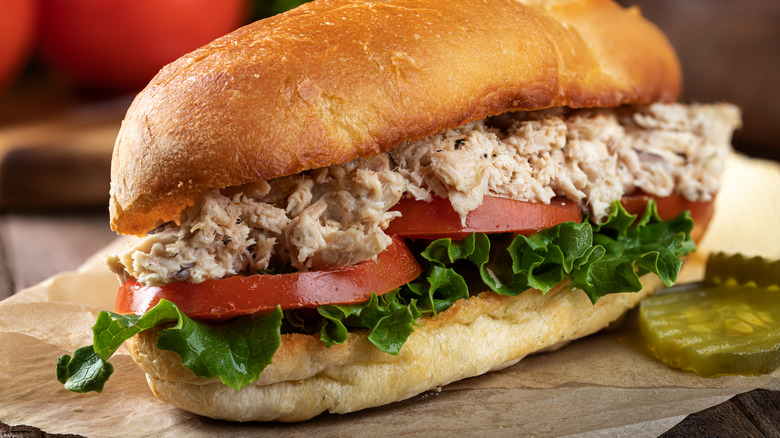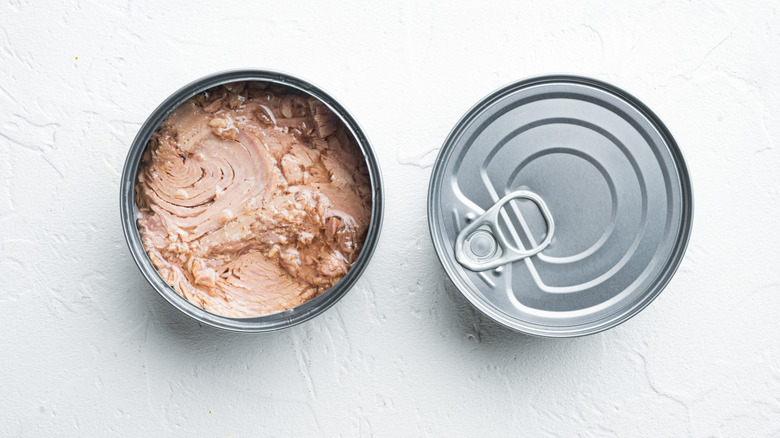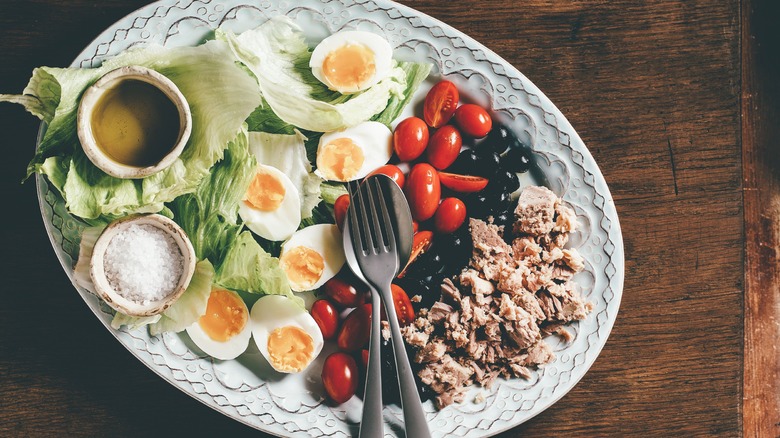Is Water-Packed Or Oil-Packed Canned Tuna Better For Salad?
For us habitual sandwich-lunch eaters, tuna salad is always a key pick. That's because it's endlessly customizable, you can experiment with its dressings (it doesn't always have to be mayo, people), and best of all, it's easy to make. But the one thing you need to keep in mind is the tuna itself because it's the star of the show. In terms of what's broadly available, you can purchase tuna packed in water, broth, or oil.
Because of that, you're going to need to make a decision. Is tuna salad better if you use the kind bathing in oil, or is it better if you use the type that comes soaking in a neutral liquid, like water? We contacted Dennis Littley, the chef behind Ask Chef Dennis (as a fellow Dennis, I approve of his name), about how he approaches the matter. Littley says it's really about what you're looking for you in your end product.
"When it comes to choosing between water-packed and oil-packed tuna, oil-packed tuna generally has more flavor because the oil helps retain the tuna's natural richness. It also gives it a more silky, tender texture, making it ideal for salads where you want a richer, more indulgent feel," he explained. So this is another one of those things where it all comes down to preferences. If you're looking for a lighter tuna salad where you have total control over how much fat you add, then you'll want to go with the water-packed tuna. But if you're looking for a more robust, meaty flavor with a luxurious texture, you'll want to go with the kind packed in oil.
When you'll want to use tuna packed in water
When it comes to water packed tuna, Littley says it's "a bit leaner and flakier, which some people prefer for a lighter tuna salad." That's why tuna packed in water is a good vehicle for all-purpose tuna salad sandwiches, like the type you generally make with mayo (or other creamy options, like tzatziki or even ranch dressing) and whichever mix-ins you prefer (popular options include celery, onions, and capers). That's because your source of fat comes from the dressing you're adding to the salad, which means it's your call when it comes to choosing what brings it all together.
Want your tuna salad to be extra creamy? Go nuts with the mayo. Feel like using light mayo or a vinaigrette to bind it instead? You can do that too. The fact that your tuna is packed in water allows you to be flexible with this, though it does tend to be a little more dry as a base ingredient. That's not to say it won't be good. It's just that canned fish is already very lean on its own, so you'll want to adjust what you add accordingly.
Canned tuna in oil is at its best when it's used simply
Tuna packed in oil is almost a completely different creature altogether. That's because when tuna is packed this way, it retains a deeper, meatier flavor and the oil gives it some extra body. Littley says, "If you're using oil-packed tuna, you can include some of the oil in the salad for extra moisture and depth, but drain off any excess if you don't want it to overpower the other flavors."
You can use it in a tuna salad where it's dressed with a simple acidic, but tuna in oil also makes for an ideal topping on a bed of greens and vegetables. Take the classic salad Niçoise for example, which has ingredients like potatoes, olives, eggs, green beans, anchovies, and tomatoes, but features the tuna as the main protein.
Tuna in oil is also great on its own when eaten with some accompaniments like bread, cornichons or gherkins, mustard, or whichever other finger foods you enjoy with tinned fish. And if you want, you can still use it in a typical tuna salad. But as Littley mentions, you'll want to drain it of oil so it's not overwhelmingly rich. Otherwise, if you're looking for something to slap in between two pieces of white bread — the stuff packed in water is more ideal, and a little more flexible for when you want a quick lunch.


